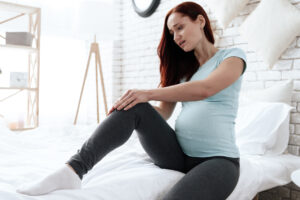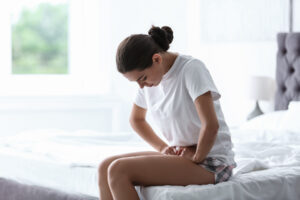
The arrival of a new baby into the family is a wonderful thing. All family members are excited to welcome the newborn! Since it is a new family member, it is also possible that family dynamics will change and be affected—especially if your older child is about to become the Big Sibling. So, what can you do to ensure introductions go smoothly?
- Share the news, but not too early! Share the news early with family and friends, but remember younger kids or toddlers have a limited sense of time: if you tell them something is going to happen, they expect it in the next moment, and non-specific waiting periods may cause worry and anxiety. Wait as long as you can, and then share the news with your older children by giving them concrete details about the timeline they can understand, like “after the snow melts,” or “when school starts”
- Your older kid may seem “older” to you, especially when a newborn arrives, but their perception of themselves is much different: they are still trying to figure out what their sense of self is, how the world works, and still have baby needs. Remind them that they will always be your first baby and be cautious to still tend to their baby needs even if you see them as older or more independent than the new baby.
- In a similar vein, because your older child may be unsure of their new role as a Big Sibling and possibly feel like more attention is given to the newborn, expect regression. Both toddlers and older children regress, even in toilet manners and sleep disruption. They need you more, so try your best to bring them closer during this time and give them extra cuddles, hugs, and babying them.
- Include them in the baby’s life in tangible ways, placing the attention on them: tell them the baby was waiting for them to get back from school, or allow them to open presents that arrive in the house. Young children like to help, so try and make them your sidekick in taking care of the baby: they can hold a toy for you while you buckle in the baby, or hand you a towel during bath time. These small acts go a long way in a toddler’s world!
And finally, remember that jealousy is normal. There is no doubt that in a healthy family environment your children will become friends, but that is in due time. For the time being, show your older child that there is a balance between the attention you give to the baby and the attention you give to them: remind them of the things you do together, and recognize that negative feelings should be expressed and are not necessarily bad—it’s all part of this new process the whole family is in!
Our offices, serving Buffalo, Williamsville, and WNY, are accepting appointments for new patients. Click here to learn more: WYN OBGYN.
More
 Proper female hygiene is one of the most important gifts a woman can give her body. It not only ensures great personal hygiene, but it also protects us from facing more severe health issues that may be cause by poor female hygiene. Learning how to properly care for ourselves, however, can be a bit tricky as there is a lot of untrue information circulating the internet, and numerous products on the shelves that promise good hygiene but may not actually be that safe to use.
Proper female hygiene is one of the most important gifts a woman can give her body. It not only ensures great personal hygiene, but it also protects us from facing more severe health issues that may be cause by poor female hygiene. Learning how to properly care for ourselves, however, can be a bit tricky as there is a lot of untrue information circulating the internet, and numerous products on the shelves that promise good hygiene but may not actually be that safe to use.
These are some of the most common myths about female hygiene:
- You Need Special Products—no, you do not. The vagina has the ability to self-clean, and the vulva can be cleaned by thoroughly washing it with lukewarm water. You may use a mild, unscented soap if you wish, but make sure to wash off with plenty of water and pat the area dry, as extra moisture enables bacteria growth.
- Vaginal Discharge Means Yeast Infection—it doesn’t. Vaginal discharge is absolutely normal and varies throughout your cycle. Secretions help remove bacteria and dead cells, thus keeping a healthy balance of vaginal flora. Healthy discharge does not have a strong odor or color and it shouldn’t cause discomfort. If you notice a strong odor, discharge that is abnormal to your body, and soreness and itching on the vaginal area, then you may be experiencing symptoms of an infection.
- Vaginal Odor Means I Have an STI—not always. Every vagina has a distinct smell that also varies throughout the cycle, any may be more potent after you sweat or after sexual intercourse. More often, vaginal odor can be a symptom of bacterial vaginosis: this happens when there is a change in vaginal bacteria, but it is not an STI. As a rule, vaginal odor on its own is not a sign of an STI, but if it comes along with soreness, itchiness, abnormal discharge, or other signs it may require further attention.
- Douching Maintains Vaginal pH—quite the opposite! Douching is the process of water-soap or vinegar-soap into the vagina to clean it and get rid of the odor. These mixtures contain fragrances that upset the natural balance inside the vagina. Douching can disturb your vaginal pH balance and can lead to inflammation.
- Underwear Choice Doesn’t Matter—but it does. The most gentle and natural fabric for your skin is cotton. It is breathable and absorbs moisture easily, thus helping absorb vaginal discharge without trapping extra moisture. Synthetic underwear can cause redness and chafing, which may then lead to other conditions such as yeast infections.
Despite the marketing many products engage in to convince you that they are good for you, remember to check the ingredients. You do not need to risk irritating your vagina with harsh soaps, or oil-based lubes, or vaginal sprays that contain harmful chemicals. Remember that your vagina is like a self-cleaning oven, and it needs very little external products for its maintenance.
Our offices, serving Buffalo, Williamsville, and WNY, are accepting appointments for new patients. Click here to learn more: WYN OBGYN.
More

Nearly every woman who has gone through menopause can attest to the numerous changes that come with it and are the results of lower estrogen levels in female bodies. Menopause changes can pose several health risks for women, both physical and mental. Some of the health issues postmenopausal women face are:
- Heart Disease: Estrogen helps keep blood vessels flexible, but this is a benefit that’s lost after menopause. A study published in February 2021 also linked persistent hot flashes to future cardiovascular disease.
- Osteoporosis: Women’s bones are protected by estrogen before menopause, but a year before menopause is finalized and for a few years after, the American College of Obstetricians and Gynecologists has found that bone loss is very rapid.
- Weight Gain: Though many women consider this solely an issue of aesthetics, the changing metabolism resulting from menopause actually puts women in risk of type 2 diabetes.
- UTIs: The vaginal tissue can become thinner and drier due to lower estrogen levels, thus increasing the risk of UTIs, as bacteria has more fertile ground in which to grow.
Along with the physical issues that women face as a result of menopause, studies also find that older women are also more likely than men to develop not only chronic health problems, but also cognitive problems. Anxiety, for example, affects 10-20% of older adults, but it often goes undiagnosed or is misdiagnosed as a side effect of other medications. Older adults may often leave mental health issues untreated since they commonly dismiss them as aches of their older age. Here are some ways in which you can recognize anxiety in older adults and help them seek appropriate treatment:
- Generalized Anxiety Disorder (GAD) may be what we most often see older adults struggle with, as those with GAD worry about a plethora of things (such as declining health, money, safety, family problems) when there may be little to no reason for such worries. It can lead to sleeplessness and difficulty relaxing, as well as fatigue, aches, irritability, nausea, and other physical symptoms.
- Social Phobia or Social Anxiety Disorder is when someone feels anxious or overly self-conscious in social situations. Older persons may experience heightened self-consciousness or embarrassment in social situations because of possible declining health, aging, and change in appearance. This can lead to loss of friendships or difficulty socializing, and can be accompanied with physical symptoms of sweating, trembling, and difficulty talking.
- Specific phobias, in general, mean the intense fear of a situation, place, or event that may pose little to not threat. Phobias common among elders are fear of death and disaster to family. Thinking about, or facing, these situations can cause severe anxiety or a panic attack.
Remember that even though older adults may dismiss issues of mental health, these problems are very real and can have a severe effect on physical health. Thankfully, they are also treatable with the assistance of a mental health professional or consistent therapy. Contact our offices, serving Buffalo, Williamsville, and WNY, to schedule an appointment to talk to your doctor about your body’s menopausal changes: WYN OBGYN.
More

Becoming pregnant comes with a myriad of changes: mood swings and hormonal rollercoasters, as well as necessary—and many times unavoidable—changes to the body. Pregnant women have to be mindful of their diets, as well as their mental and physical condition. Another cause of concern during pregnancy is arthritis: can you develop arthritis after pregnancy? Does having arthritis affect your ability to become pregnant? Let’s explore some of these questions.
Developing Arthritis
There does not seem to be a direct correlation between becoming pregnant and developing arthritis either right after your pregnancy or later down the road. It is rare that women will develop rheumatoid arthritis after pregnancy, and this is only if the immune system attacks healthy joint tissue.
However, there are some elements of pregnancy that cause joint pain:
- Physical Demands of Pregnancy and Motherhood: Postpartum joint pain, or during pregnancy, can be caused because of the extra weight in your body. Your hips and knees may suffer because of it; sometimes your fingers too. Though most symptoms decline after childbirth, there is a chance they may stick around for longer and even develop into lifelong conditions. Applying ice packs and using compression bandages on areas that ache can help relieve the symptoms.
- Fluid Retention: As you may know, fluid retention is a common side-effect of pregnancy. This can also increase the risk of carpal tunnel syndrome, a condition that occurs when the median nerve in the hand is compressed. Fluid retention may also mean that fluid builds up the wrist, causing pressure on your hand nerves.
- Post-Partum Hip Pain: This is also known as Pelvic Girdle Pain (PGP), and it affects joints in the pelvic area. The most common cause of PGP is because the hips can become unstable during pregnancy. Its symptoms include pain in the pubic area, pain that seems to worsen with activity, radiating pain in your lower back, and popping sounds when you move your hips.
Pregnant with Arthritis
Generally speaking, you can become pregnant if you have arthritis. However, since certain medications can affect your baby or interfere with your ability to conceive, you should consult your doctor beforehand.
Symptoms of arthritis during pregnancy may worsen, as your body is carrying on extra weight. Added pressure on your spine can cause muscle spasms or numbness in your legs. Additionally, remember that sometimes pregnancy hormones change our perception of pain: as such, pain that was moderate before your pregnancy may be experienced as much higher when you are pregnant.
If you are taking medication for arthritis, consult your doctor on what medication is safe to continue, and which ones aren’t. Continue to be mindful of both medication and pain-reliever intake if you plan to breastfeed. Remember to exercise during pregnancy, so you can assist your body in promoting flexibility and muscle strength. If you are worried about the safety of your exercise routine when it comes to your baby, always consult a medical professional.
More
By Iris Farrou
05 Dec, 2021
Women's Health
Best gyns in Buffalo, Best OB practices in Buffalo, Best OBGYN Groups in Buffalo, Buffalo OBGYN, Chouchani MD, endometriosis, WNY OB-GYN, WNY Ob-gyn doctors, WNY OBGYN, women's health

If you have been diagnosed with endometriosis or may suspect you are included in the percentage of the female population that has it, you may be concerned about your fertility levels and/or conceiving and carrying to term. Endometriosis is very common and affects between 6% and 10% of the general female population. About 30%-50% of women with it are infertile, and about 25%-50% of infertile women have endometriosis.
Here are some options to consider if you are diagnosed with endometriosis and are interested in becoming pregnant:
Expert Assistance
It is possible that some surgical operations associated with the diagnosis and treatment of endometriosis may affect your ability to become pregnant, so if you haven’t yet undergone any surgical procedures, it would be a good idea to discuss the risks with your doctor. You may also want to consider working with a fertility specialist who will help you find out the contributing factors to your infertility and determine the severity of your disorder.
Improving your Chances
There is no current evidence that suggests medication can assist you in getting pregnant if you live with endometriosis. However, your doctor may instruct you to take progestins so you can increase the level of pregnancy hormones in your body. Another suggestion is to follow a healthy lifestyle so you can decrease the chances of inflammation in your body and help your baby thrive throughout a healthy pregnancy:
- Maintain weight that is healthy for your body type.
- Engage in moderate exercise in your daily life.
- Consume nutrient-dense foods.
Treatments
- Fertility medications are fairly common for women with endometriosis. These can range from progestin injections to fertility medications like Clophemene to help you produce 2-3 mature eggs.
- You may also undergo regular ultrasounds to determine the maturity of your eggs. At the appropriate time, your doctor can insert collected sperm to assist in conceiving.
- In vitro fertilization is also an option couples go for, whereby the egg is fertilized outside the body and then inserted into the uterus.
- If you have mild endometriosis, or your endometriosis has not affected your fallopian tubes, you may consider intrauterine insemination.
- A more costly option, and usually not covered by insurance, is to freeze your eggs. Endometriosis can affect your ovarian reserve, so this option helps if you want to try and become pregnant at a later time.
The good news is that many women living with endometriosis have managed to get pregnant using IVF, especially in cases of moderate or mild endometriosis. Though the chances are about 50% less than those of couples who use IVF due to other infertility reasons, many women with endometriosis are able to conceive and deliver a healthy baby. It is recommended that you start discussing your fertility options with your doctor even before you are thinking of getting pregnant.
Learn more about IVF: https://wny-obgyn.com/2022/03/ivf-step-by-step/
More
 If you have heard the word, you probably know endometriosis comes with pain. The endometrium is tissue that lines the inside of your uterus. In the case of endometriosis, tissue similar to endometrium grows on the outside of your uterus, involving your ovaries, fallopian tubes, and the tissue lining your pelvis. When this occurs, the endometrial-like tissue acts like the inside of your uterus on each menstrual cycle: it thickens, breaks down, and bleeds. However, it has no way outside of your body, so it is trapped and leads to excessive pain.
If you have heard the word, you probably know endometriosis comes with pain. The endometrium is tissue that lines the inside of your uterus. In the case of endometriosis, tissue similar to endometrium grows on the outside of your uterus, involving your ovaries, fallopian tubes, and the tissue lining your pelvis. When this occurs, the endometrial-like tissue acts like the inside of your uterus on each menstrual cycle: it thickens, breaks down, and bleeds. However, it has no way outside of your body, so it is trapped and leads to excessive pain.
What else happens?
If endometriosis has moved to the ovaries, cysts called endometria may form. As a result, surrounding tissue becomes irritated causing scar tissue and adhesions. It is possible that these adhesions can cause pelvic organs to stick to each other.
What are the symptoms?
One of the first symptoms of endometriosis is extreme pain during menstruation, far more intense than regular period cramps. However, the amount of pain is not a good measure for how severe your case of endometriosis may be: you can have a serious case of it with little to no pain, or a mild case with a lot of pain. Pain that’s associated with endometriosis may become worse with time, and the following symptoms often accompany it:
- Painful periods for extended time: pelvic pain and cramping may begin before your period and extend for days after it, coupled with abdominal pain and lower back ache
- Pain during or after intercourse is common with endometriosis
- Pain with bowel movements or urination
- Bleeding excessively during your period, or bleeding in between periods
- Infertility is also associated with endometriosis, as the condition is often found when women seek fertility treatments
Some other symptoms of endometriosis may include fatigue, diarrhea, constipation, and bloating or nausea.
What causes it?
Some of the most common causes associated with endometriosis are:
- Retrograde menstruation: when menstrual blood containing endometrial cells flows back into the fallopian tubes and into the pelvic cavity, not out of the body
- Transformation of peritoneal cells: when cells that line the inside of your abdomen become endometrial-like cells due to hormones or immune factors
- Embryonic cell transformation: when embryonic cells turn into endometrial-like cells during puberty
- Immune system disorder: when your body would not recognize and destroy endometrial-like tissue as a threat that is growing outside of your uterus
What are some of the available treatments?
Treatments depend on how severe your case of endometriosis is, and medication is taken as a first approach, with surgery following in extreme cases.
- Pain medication to ease menstrual cramps
- Hormonal contraceptives to control the hormones responsible for the buildup of endometrial tissue each month
- Progestin therapy can stop menstrual periods and the growth of endometrial implants
- Gonadotropin-releasing hormone (Gn-RH) agonists and antagonists block the production of ovarian-stimulating hormones, thus lowering estrogen levels and preventing menstruation, and leading to endometrial tissue shrinking
- Aromatase inhibitors is another way to reduce the amount of estrogen in your body
More
By Iris Farrou
27 Aug, 2021
Women's Health
Best gyns in Buffalo, Best OB practices in Buffalo, Best OBGYN Groups in Buffalo, Buffalo OB-GYN, Buffalo OBGYN, Chouchani MD, WNY OB-GYN, WNY Ob-gyn doctors, WNY OBGYN, women's health, women's health tips
 Swimming is a wonderful way to exercise, relieve stress, practice less strenuous physical therapy, and many other benefits. Especially in the summer, we use swimming not only as a way to cool down, but also as the primary relaxation technique. After all, what is summertime without imagining ourselves by a pool or by the ocean?
Swimming is a wonderful way to exercise, relieve stress, practice less strenuous physical therapy, and many other benefits. Especially in the summer, we use swimming not only as a way to cool down, but also as the primary relaxation technique. After all, what is summertime without imagining ourselves by a pool or by the ocean?
We are already deep into the summer season, so our bodies have most likely been deep into pools, fresh water, or the sea. Along with the many positive effects that swimming can have on our physical and mental health, there are some elements that pose a threat to female hygiene and vaginal health: the widely dreaded yeast infections.
How are they caused?
Yeast infections are, essentially, fungal infections that cause irritation and discharge, as well as extreme itchiness. They thrive in conditions that help fungi develop: water with bacteria, or water with chemicals, as well as lounging in our swimsuits after swimming—innocently drying off in the sun while giving bacteria ample space to thrive.
How do we prevent them?
Currently over 138 million women suffer from recurrent candid, another name for yeast infections, so sound advice and safe habits can go a long way in preventing swim-induced infections.
- Immediately rinse off in a shower after swimming and change into dry swimsuit bottoms or fresh underwear. This drastically reduces the risk of bacterial development.
- Wash your swimwear when you get home. Use dye-free or sensitive laundry detergent, or if unavailable, rinse thoroughly with fresh water for several minutes. Hang your swimsuit up to dry completely before using it again.
- Reduce or eliminate your exposure to chlorinated water, especially in a hot water environment like a hot tub. This is a more drastic measure meant for those of us who are very prone to UTIs and candida, are pregnant, on antibiotic or certain medications, have diabetes, or a weakened immune system that may lead to yeast infections developing more easily.
- Keep your body hydrated with clean drinking water to assist your bladder in flushing out the bad bacteria and keeping the good bacteria. Remember that the female vagina is almost like a self-cleaning oven, and you can assist it in keeping itself healthy. Eating probiotic foods or taking liquid probiotic supplements, as well as reducing our intake of alcohol and sugary foods can also fortify vaginal pH balance.
What are some symptoms?
- If you experience increased frequent need to urinate, painful urination, chills, burning urination or even lower back aches, you may have developed a urinary tract infection as well.
- Increased discharge that potentially smells stronger and is gray colored, along with vaginal itching, tenderness and/or swelling are all signs of yeast infections.
As always, pay attention to what your body is feeling and doing. If something doesn’t feel, look or act normal down there, contact your gynecologist or general practitioner immediately. Yeast infections and UTIs are nothing to be embarrassed about, and important to address quickly for physical and mental wellness.
More
By Iris Farrou
30 Jul, 2021
Women's Health
Best gyns in Buffalo, Best OB practices in Buffalo, Best OBGYN Groups in Buffalo, Buffalo OB-GYN, Buffalo OBGYN, Chouchani MD, WNY OB-GYN, WNY Ob-gyn doctors, WNY OBGYN, women's health, women's health tips
During times of high heat and temperatures, it is not uncommon to experience excessive sweating. Additionally, women are all too familiar with night sweats and changes in their body temperature during their menstrual cycle; especially when progesterone levels increase and estrogen levels decrease, the part of your brain that controls internal temperatures (hypothalamus) is affected, resulting in irregular sweating. However, excessive sweating may not only be based on hormonal changes but be the cause of something more serious.
What is it?
Excessive sweating is also called hyperhidrosis and it occurs when you sweat more than you would expect based on your surroundings, temperature, and stress levels. It can affect your entire body or just certain areas like your palms, soles, underarms, or face. When there is no underlying medical cause, it is called primary hyperhidrosis, but when there is an underlying cause, it is secondary hyperhidrosis. Conditions that may cause excessive sweating include diabetic hypoglycemia, hyperthyroidism, fever, acromegaly, infection, menopause, medication side effects, and neurologic diseases.
Cause for Concern
Based on the above list, there may be many reasons why you are experiencing excessive sweating, and most of them would require some time to figure out. However, if excessive sweating is accompanied by lightheadedness, nausea, or chest pain, you should seek immediate medical attention. You should still visit your doctor if you suddenly sweat more than usual, especially if this disrupts your daily routine. If you experience night sweats for no clear reason, you should also contact your doctor. It is especially concerning if your sweating is causing you to socially withdraw or be emotionally distressed.
Treatment
If an underlying medical condition is what causes excessive sweating, then this should be treated first. If this is not the case, however, then your doctor may provide you with the following solutions:
- Prescription antiperspirant or prescription creams that focus on hyperhidrosis on the head and the face.
- Nerve-blocking medications to block the chemicals which allow nerves to communicate with one another.
- Antidepressants as they can help decrease both sweating and the anxiety that may be causing hyperhidrosis.
- Botulinum toxin injections temporarily block the nerves that cause sweating.
This is not an exhaustive list of treatments used to treat excessive sweating, but they are the most common ones. Keep in mind that it makes a big difference in treating the condition whether it is primary or secondary hyperhidrosis, and that should you experience constant symptoms of it you should address it with your primary physician first and foremost.
More
 The average adult needs 7 to 9 hours of sleep each night to lead a healthy life, assist in their mental health, and boost their physical health. Getting a good night’s sleep helps our mood, immune system, and energy levels. Overall, adult women sleep an average of 11 minutes more than men, but research shows their quality of sleep is lower, which signals sleep problems. One reason for sleep problems could be that women are more likely to interrupt their sleep and its quality to take care of others (such as nursing or waking up to tend to a newborn), but it is also attributed to biological factors like changing hormones during menstruation, pregnancy, and menopause.
The average adult needs 7 to 9 hours of sleep each night to lead a healthy life, assist in their mental health, and boost their physical health. Getting a good night’s sleep helps our mood, immune system, and energy levels. Overall, adult women sleep an average of 11 minutes more than men, but research shows their quality of sleep is lower, which signals sleep problems. One reason for sleep problems could be that women are more likely to interrupt their sleep and its quality to take care of others (such as nursing or waking up to tend to a newborn), but it is also attributed to biological factors like changing hormones during menstruation, pregnancy, and menopause.
Common Sleep Problems, Causes, and Remedies
Insomnia: more than 1 in 4 women in the U.S. suffer from insomnia, having difficulty falling and staying asleep. Though insomnia is more common in people with depression and anxiety—also conditions more likely to affect women—hormonal shifts during menstruation, pregnancy, or menopause affect a woman’s circadian rhythm, resulting in sleeplessness. During menopause, hot flashes and night sweats also disrupt women’s sleep.
Treatment starts from trying to keep a regular sleep schedule, reducing caffeine and alcohol consumption, and improving the sleeping environment. Underlying conditions are, of course, also treated properly with medication and therapy so that chances of them contributing to insomnia can be lessened.
Restless Leg Syndrome: during pregnancy and if taking depression medication, women are more likely to experience RLS, a condition that occurs when lying down and is an uncontrollable urge to move the legs. The risk of it increases from pregnancy to menopause, and women with more children are more like to suffer from it. One possible cause is iron deficiency.
Treatment can include improving sleep habits and the sleeping environment and/or taking iron supplements. Be mindful that about 80% of people with RLS may experience periodic limb movement disorder, which leads to involuntary twitching of the legs every 20 to 30 seconds.
Sleep Apnea: another one of the most common sleep disorders is sleep apnea, and it unfortunately tends to go undiagnosed in women as they report more general symptoms associated with it. Sleep apnea is characterized by pauses in breathing during sleep, leading to snoring, chocking, and gasping sounds that disrupt sleep. The risk for sleep apnea increases in women over 50 and those who may be obese.
Women who may suspect this condition should pay attention to the specific signs of breathing difficulty to report to their doctor. Though CPAP therapy is the most common, it is also likely hormonal treatments will help with the symptoms, or increased exercise and lifestyle changes to reduce fat.
These are a few of the sleep problems that are most common among women, and when reporting to your doctor or healthcare professional it is important to remember that your overall health history is to be taken into consideration when dealing with sleep disorders. Additionally, irregular work schedules or increased duties in women’s lives are factors that increase their chances of suffering from a sleep disorder.
More
By Iris Farrou
29 Jun, 2021
Women's Health
Best gyns in Buffalo, Best OB practices in Buffalo, Best OBGYN Groups in Buffalo, Buffalo OB-GYN, Buffalo OBGYN, Chouchani MD, WNY OB-GYN, WNY Ob-gyn doctors, WNY OBGYN, women's health, women's health tips

Rather more serious than the usual activity-induced fatigue, Chronic Fatigue Syndrome (CFS) or Myalgic Encephalomyelitis (ME/CFS) is a chronic illness that is known to affect more than 1 million Americans. Women are four times more likely than men to be diagnosed with it. Keep in mind that it is different from expected fatigue, as it often disables people from doing simple daily tasks such as showering or dressing and may also confine people to bed.
Along with the general description we are provided about chronic fatigue, we know of three key symptoms:
- ME/CFS is accompanied by fatigue that lasts more than 6 months, and it is not the result of usual effort, nor is it made better when resting
- Symptoms become worse after mental, physical or emotional effort that would not have caused any issues before the illness
- Sleep does not get the job done, as people with ME/CFS may be just as tired after a full night’s sleep, not refreshed
Causes
Medical professionals do not yet know exactly what causes ME/CFS, but speculate it is possible there is more than one cause. It is also assumed that there may be a variety of triggers for the condition, such as infections or changes in the immune system. Patients report that CFS starts after flu-like illnesses or a cold/stomach bug, while others also link it to periods of extreme stress—which can of course affect body chemistry. There are no conclusive results yet, but another scientific hypothesis is that ME/CFS is linked to the virus that causes mono, Epstein-Barr.
Treatment
Because of the inconclusive results on what exactly causes ME/CFS, it is difficult for medical professionals to suggest treatment for it, nor is there a CDC approved treatment. However, it is possible to treat certain symptoms to provide relief for some patients. Since it is not a guarantee, unfortunately many people learn to live with it and manage the symptoms to the best of their ability with the support of their family and friends.
Most commonly, healthcare professionals work with patients to address post-exertional malaise and help patients understand, and find, their limits when it comes to physical and mental exertion and create routines as well as “energy envelopes” to manage their fatigue. Sleep problems can also be addressed with either tips for good sleep habits, over the counter medications, or even prescribed sleep medications. Pain of muscles and joints is also addressed in the same manner, and even alternative medicine may be suggested.
Additional symptoms of ME/CFS may include dizziness, loss of memory and/or difficulty concentrating as well as depression and stress. Keep in mind that experiencing individualized or sporadic symptoms listed here is not a conclusive diagnosis for chronic fatigue, and should you suspect, you may be suffering from it, it is best to reach out to your doctor.
More










